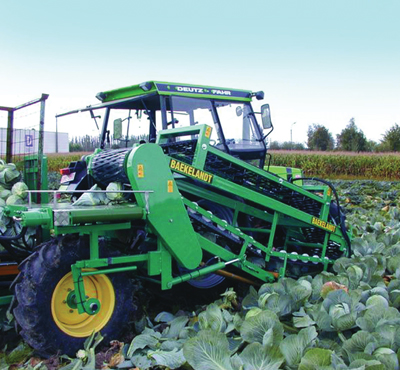
Equipment
Spraying
U.K. scientists developing intelligent harvesting robot
September 25, 2009 By Fruit & Vegetable
Researchers at the National Physical Laboratory (NPL) in Teddington, UK, have developed imaging technology to be used in an intelligent harvesting machine that could minimize wastage and solve an impending labour shortage for farmers.
Researchers at the National Physical Laboratory (NPL) in Teddington, UK, have developed imaging technology to be used in an intelligent harvesting machine that could minimize wastage and solve an impending labour shortage for farmers.
 |
| Photo courtesy Vegetable Handling Systems Advertisement
|
Annual waste for certain crops can be up to 60 per cent – which can mean up thousands of dollars of lost revenue for an average farm every year, according to farmers who were consulted during research. Falling numbers of migrant workers means that healthy crops cannot be gathered and so farms are losing crops due to harvesting at the wrong time.
NPL’s scientists are working with KMS projects and Vegetable Harvesting Systems (VHS) to turn the technology into an intelligent harvesting machine that can look beneath the leafy layers of a crop, identify the differing materials, and enable precise size identification. This can be used to develop a fully automated harvesting robot, which would be able to fill the gap left by the labour shortage.
The most appropriate technologies to use are radio frequencies, microwaves, terahertz and the far-infra red. These four parts of the electromagnetic spectrum all have potential to safely penetrate the crop layers and identify the size of the harvestable material for a relatively low cost. NPL has developed a methodology for crop identification and selection focusing on cauliflower crops, one of the hardest crops to measure due to the large amount of leafage that covers the vegetable.
The researchers at NPL began by modifying microwave measurement systems to measure a cauliflowers structure. A series of measurements made on real crops in the laboratory and field enabled a statistical range of measurements for precise size identification. This data is then designed into an algorithm to enable a simple size indication from a raw measurement with uncertainties. The final technology will be developed for a first generation harvester and tested in a real farming environment.
A successful demonstration of the imaging technology was given recently at the Fanuc Robotics site in Coventry, showing its huge potential for the harvesting of cauliflowers, lettuces and other similar crops. This has attracted further commercial support from G’s, one of the largest lettuces grower in Britain, to take the project forward and develop the complete product, which could be available as early as next year.
“The farming industry does not have access to equipment or the skills required to operate in these parts of the electromagnetic spectrum, few places do,” said Dr. Richard Dudley, project lead at NPL. “That is why KMS Projects and VHS came to NPL to utilize the world class expertise and equipment that we have on site to try and address this problem. Our aim is to develop a unique new automated harvesting machine that will dramatically improve productivity in the UK and global farming industry and ultimately benefit consumers through cheaper food in the supermarkets.”
Print this page